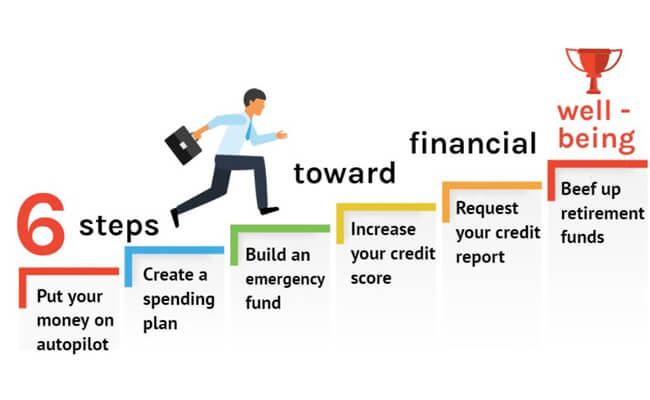 Image Source:nizaricu.org/articles
Image Source:nizaricu.org/articles
Finances can be easily overwhelming and seemingly impossible to manage especially when starting a business, but if 28.8 million U.S. small businesses can do it, then so can you.
Research Your Field
The first step in creating a solid financial plan for your small business is researching your field beforehand. Small businesses make up 99.9% of all United States businesses, so your field is most likely already created. Do your research first so you will know how to make your business unique and know what you need to achieve uniqueness which, in turn, will help you know what to budget for.
Researching Necessary Equipment
First off, what equipment are you going to need for your business? This is possibly the most important question to research because equipment can often times take up the bulk of your startup costs. Necessary equipment can cost anywhere from $10,000 to $125,000, depending on what your field, business, and skills require of course.
Will you Be a Part of the 69% of Entrepreneurs Who Work at Home?
Can you use your home as your office, work space, manufacturing space, etc., or will you need to rent a space for your business? Many creativity-based business owners – artists, writers, seamstresses, etc. can run everything from the comfort of their own homes, because their equipment and products often take up reasonable amounts of space. However, there are thousands of businesses that thrive on renting an outside space. Consider this question when you’re researching your necessary equipment and if it becomes too much for the average household, note to put aside some money for renting a space.
What are the Friendliest States for Small Businesses?
Similar to the last question, research which states in the U.S. are the most suitable for new small businesses. Are you more likely to succeed in your current state of residence or a different one?
For example, Based on a study by Thumbtack, South Dakota proved to be the friendliest state for small businesses while Illinois proved to be the least friendly state for small businesses. Additionally, small businesses in Virginia tend to have the highest annual revenue while small businesses in Hawaii have the lowest annual revenue. Consider these factors when starting your business and formulating a financial plan.
Market Research
Finally, the last important thing to research before starting your business is what customers think about your general field or Market Research. With this research, you can keep in mind how successful your field already is, what you can do to tailor your business to customers’ interests, and if your field or business idea is something the market needs right now.
In fact, one of the biggest cause of failure is because 42% of industries or small businesses are not needed in the current market.
Market Research will also tell you who your customers will be and what they will be wanting or needing from you. Learn from surveys, statistics, ad success rates, and phone campaigns to get a good idea on how to tailor your field and which customers you need to target.
Creating a Business Budget
This step can be quite overwhelming and enough for some people to quit their dream of entrepreneurship before they even begin. However, creating a business budget is a crucial step in starting your business. Essentially, a business budget is your crystal ball, your eye into the future success of your company.
A business budget works by documenting your success and revenue thus far and therefore letting you know what you should or shouldn’t invest in in the coming month. Or if you’re just starting out, it works by documenting how other businesses in your field have profited what you should and shouldn’t spend money on while getting started.
In short, a business budget is necessary for the organization, keeping control of your business finances, making business production more efficient, and predicting both unsuccessful and successful months.
Examine Revenue
The first step in creating a business budget is examining your past revenue, or if you’re new to entrepreneurship, examining similar businesses’ revenue.
Do enough research to come up with an estimation of monthly income (from the past 12 months) for your industry. Once you get your business on its feet for a while, you will be able to add up your own monthly revenue for a more accurate, personal budget.
Note that when you’re summing up income, you need to calculate revenue – the money earned before expenses are deducted – not profit, which is the remaining money after deducting expenses.
Subtract Fixed Costs
The second step in the process of creating your business budget is to add up fixed costs, which are recurring costs that are necessary for your business. For example, if you were starting a photography business, your fixed costs may be memory cards for your camera, external hard drives to keep your files in, or props and backgrounds for your studio.
Or this could include merchandise for your business: t-shirts, stickers, pens, or enamel pins custom. While merchandise may not seem like a necessity, it sure is a great way of promoting your business and getting your name out there. Consider this when budgeting!
Other general examples would be; rent, supplies, taxes, etc. Each small business will have a unique list of fixed costs, so make sure to do enough research to know what yours will be if you’re just starting up.
Once you have a realistic list of your fixed costs, subtract this from your income.
Determine Variable Expenses
The third step in creating your business budget is calculating your variable expenses, which are expenses or supplies that need to be replaced depending on how often you use them.
Some examples of variable expenses are your own salary, old or broken equipment, and office or work space necessities.
In the future, you can raise or lower these expenses based on if you’re having a profitable month or if you’re not having a profitable month.
Saving Money for Unexpected Costs
Just like any organization, business, or any plan really, something will occasionally break or ruin at the very last second. When this happens, you need to make sure you set aside money in your business budget for events like this.
An emergency fund is important for a new business especially, because it’s a time of learning what to do and what not to do. Or in other words, it’s the prime time for mistakes and unexpected emergencies. Save yourself the stress and trouble, plan ahead for emergencies!
Make a Profit and Loss Statement
The fifth step in creating a business budget is simply adding up your monthly income and your expenses (separately) for preferably the past 12 months. Once again, if you’re new to the small business world, do enough research to get a rough estimate of your monthly income and expenses. Once you’ve done this, subtract your expenses from your income.
If you end up with a positive number, that’s how you know you’ve made- or will make- a profit. If you end up with a negative number, no need to worry! This number can provide insight on what you need to budget better so that you can work towards making a profit.
Also, take heart in the fact that most businesses don’t make a profit every month, and sometimes not every year either. In fact, 40% of businesses make a profit, 30% break even, and the last 30% don’t make a profit. The odds are that you will make a profit or break even the majority of the time. It’s all about learning to make improvements which will hopefully turn into profit.
Create a Business Budget for the Coming Months
The last step in creating a business budget is using your budget data from the past 12 months to estimate what money you will make or lose in the following months. This is the “crystal ball” part of the business budget.
Use your Profit and Loss Statement to predict profitable months, non-profitable months, fixed cost estimations, and variable cost estimations. This will give you a good sense of control over your business because it will prepare you for every failure and success.
Use your Profit and Loss Statement to plan things like; big purchases, economic turmoil, weather emergencies that can ruin your products, and seasonal trends.
Average Business Startup Costs
Now for probably the most overwhelming part of starting a business: how much you have to spend just to start. According to the Kauffman Foundation, it costs approximately $30,000 to just start. Pretty insane, right?
Common Expenses
According to Fundera, the most common and most important startup expenses are:
Equipment: $10,000-$125,000
Incorporation Fees: approximately $300
Office Space (depending on your field or whether you need it): $100-$1,000 monthly, depending on number of employees
Inventory: 17-25% of budget
Marketing: 0-10% of budget
Website: approximately $40 per month
Office Furniture and Supplies: (depending on whether or not you’re starting from home or if you already have an office space) 10% of total budget
Utilities: (dependent on if you’re renting an office space or not) approximately $2 per square foot of office space
Payroll: (dependent on number of employees, if any) 25-50% of total budget
Professional Consultants: $1,000-$5,000 annually
Insurance: approximately $1,200 annually
Taxes, Travel, and Shipping: variable
All listed startup costs are dependent on your specific industry. Most of these costs differ for every entrepreneur. While these costs can easily break the bank, it’s important to remember that a third of small businesses start with less than $5,000 and 58% started with less than $25,000. While all these extraordinarily large price tags are overwhelming, just remember that it is possible to start a business on a tighter budget than what is listed here.
How to Receive Loans for Startup Costs?
There are numerous ways to finance a new small business. In 2018, the most popular small business financing methods were: personal funds (77%), bank loans (34%), and borrowing or receiving donations from family and friends (16%). The first and last of these popular financing options are self-explanatory, so in this article, we will only discuss how to receive loans.
Review Your Startup Costs
One way you can do this is to separate your startup costs list into 2 categories: what you already have and what you need. Now focus on the list of what you need: what can you pay for with your money or donations from family and friends? What do you need help with?
Once you narrow down your costs to ones you need loans for, you can get started on the next few steps.
Prepare Your Documents and Registrations
According to the NSBA, 27% of small businesses cannot get the funding they need for startup costs. Receiving loans is a really challenging feat, especially for young companies because there is no proof of revenue or history of a successful business. However, it’s easier to receive a loan when the entrepreneurs prepare.
The best way to prepare is to create a business plan. This kind of preparation proves that while you are a new entrepreneur, you are eager to be successful and you are arming yourself with a plan.
The next necessary preparation before meeting with a lender is registering your startup with a local government agency. This shows, once again, that you’re taking your startup seriously which will make lenders more eager to loan money.
Other documents you will need to prepare are bank and income statements, tax returns, your personal resume, and your business budget which shows the intended direction of your small business.
Need a specific guide for meeting business loan requirements? We can help.
Reviewing Your Qualifications
When applying for a loan, your personal credit score is crucial. Because you’re in the process of starting a business, this means that you don’t have existing credit history with said business.
So, you will have to provide your personal credit score which will prove to the lender if you’re trustworthy or not. It’s best to have a credit score higher than 680. If not, here are some ways you can increase it.
Additionally, it is important to review your annual- or if you’re new, monthly- revenue and your cash flow. Remember, we hashed all this out (even for newbies) in our tutorial of how to create a business budget. Make sure you bring it for your lender and reference it.
This is important to lenders because they want to make sure you are (or you will be) bringing in enough money to eventually pay off your loans.
Cash flow is extremely important to lenders- possibly even more so than annual revenue- because it’s a fact that 82% of small businesses fail due to cash flow issues. So try to get ahead and prove your lender wrong.
Researching the Startup Loan that is Best for You
Remember the first step in this section was reviewing startup costs and determining exactly what you need loans for. Is it for equipment? An office space? Utilities or insurance? This is important in your search for not only the right loan but the right lender as well.
Another option in financing your startup is a business line of credit- a type of loan that is helpful for ongoing operations- or business credit cards- which is helpful for a revolving line of credit. Look into these options and discover which one is best for you.
How to Properly Manage Your Business Finances
Once you’ve finally got everything up and running for your business, it’s time to focus on how to keep it up and running by successfully managing your finances. The best thing you can do for your businesses’ finances is staying organized.
In order to keep organized, you need to keep some financing documents. Here are the most important ones to keep on hand according to Fundera:
Balance Sheet: used to calculate the net worth of your business and keeps you updated on your businesses’ financial standing.
Income Statement: AKA a profit and loss statement, which we went over earlier in this article. Just to remind you, it keeps track of your profitable months and years as well as your not-profitable months and years.
Cash Flow Statement: this keeps track of your money going in and out in the form of revenue and expenses.
Revenue Forecast: this is also similar to the profit and loss statement we discussed earlier. This is designed to keep track of your financial successes and failures during specific months. This is so you will be able to predict these patterns happening again as well as preventing any potential disasters.
However, even with these organization tips, at some point being the sole boss, owner, employer, etc. is going to be really overwhelming. This will become even more true as your business becomes bigger and more successful.
Therefore, the best way to stay on top of your finances is to hire a business accountant. It will help you build relationships with others and, most importantly, will take that extra weight off your back.
Conclusion
Now you have an idea of the most important financial steps that are needed to start your business. None of this will be easy, but it’s always possible for those who are bursting with talent and passion for their dream. So, get out there and get started! There is no better day than today. Please comment if you have any additional questions.
Awesome! Share To :
Receive our news



